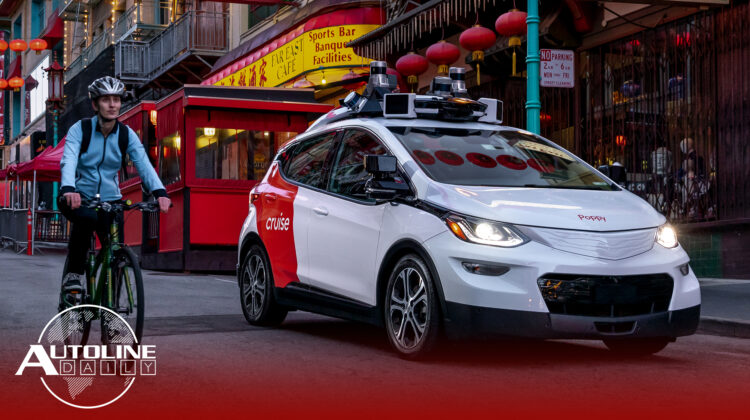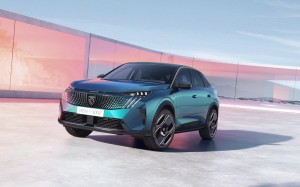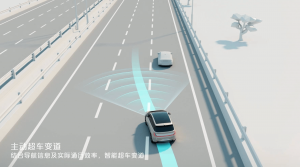
Listen to “AD #3646 – AVs Getting Closer to Human Drivers; India Moves to Phase Out Diesels; Stellantis' 1st EV on New Platform” on Spreaker.
Follow us on social media:
Runtime: 9:28
0:00 UAW Strike Looms, Two Days to Go
1:15 India Moves to Phase Out Diesels
1:51 Stellantis Reveals 1st EV on New Platform
3:28 Consumers Prefer Charging Partnerships
4:27 Nissan Revives Baseball Teams
4:52 XPeng Ditching Direct Sales for Dealerships
5:17 High-End Tech Going Into Low-End Chinese Cars
6:16 Tesla & Suppliers Spending Big in Mexico
6:47 AVs Getting Closer to Human Drivers
Visit our sponsors to thank them for their support of Autoline Daily: Bridgestone, Intrepid Control Systems, Schaeffler and Teijin.
This is Autoline Daily, the show dedicated to enthusiasts of the global automotive industry.
TWO DAYS TO GO. UAW STRIKE LOOMS
Two more days. That’s the countdown to a potential UAW strike when the current contract expires at midnight on Thursday. But we’re starting to see more progress. Automotive News reports that the union lowered its wage demands. Instead of a 45% increase, it signaled that it would settle for 36%. Ford offered a 16% increase, up from 15%. Stellantis made a counter offer yesterday, and while we don’t have the details, the company said it’s making progress and remains committed to avoiding a strike. GM had no comment on its counteroffer. The automakers have now put two offers on the table, which the union counter offered, and we think there’s one more offer to go. That final offer will probably not be made until tomorrow or early on Thursday. But when we say final offer, we mean mostly final. There’s always a bit more haggling over minor issues that takes place. And if that goes well, who knows? Maybe there won’t be a strike.
INDIA MOVES TO PHASE OUT DIESELS
It looks like India is taking the first steps to get rid of diesel-powered vehicles. The country’s transport minister announced a proposal to increase a tax on diesel vehicles by 10% and warned it could go higher if automakers don’t start selling more environmentally friendly vehicles. India currently has a 28% tax on diesels and an additional charge is added depending on the engine size. Diesels have already been falling out of favor in India with its market share dropping to 18% from 50% a decade ago.
STELLANTIS REVEALS 1ST EV ON NEW PLATFORMS
Stellantis revealed its first production EV based on one of its 4 new EV architectures. The Peugeot E-3008 rides on the STLA Medium platform, the same one used for the Dodge Charger Daytona Concept. The E-3008 will be available in a number of setups. The base model will come with a single 210 horsepower electric motor, a 73 kWh NMC battery pack and an estimated 525 kilometers or 326 miles of range. Somehow the dual motor version with the same battery pack and 320 horsepower has the same estimated range as the single motor. And rounding out the EV versions, is another single motor model, but it has slightly more power at 230 horsepower and a larger 98 kWh NMC battery pack that provides an estimated 700 kilometers or 434 miles of range. A 400-volt electrical system will allow DC fast charging of up to 160 kW. But Stellantis says there will also be hybrid powertrains available, depending on the market. The interior of the E-3008 is very futuristic-looking. It’s very wedgy and angular, features a large 21-inch floating display screen and a lot more use of fabric on the doors, dash and center console. Production should kick off soon in France and sales will start in February of next year.
CONSUMERS PREFER CHARGING PARTNERSHIPS
If you’re an automaker, how do you get more people to buy an EV? You form a partnership with one of the public charging companies. That’s according to a study from Escalent, which said partnerships that offer custom charging programs or membership privileges and discounts appeals to people considering an EV. It found that a partnership with Shell Recharge, which used to be known as Greenlots, really appealed to consumers because they likely associate it with Shell gasoline. Intriguingly, consumers also like the idea of automakers working with tech companies to design EVs like Amazon, Google, or Facebook
NISSAN REVIVES BASEBALL TEAMS
Nissan is bringing back company baseball teams in Japan. It shut down its two company-backed baseball clubs in 2009 during the Great Recession. But now they’re coming back in 2024 and 2025 as a way to get employees more engaged in company activities and bring people together. Nissan thinks by bringing back its baseball teams it will help change its corporate culture.
XPENG DITCHING DIRECT SALES FOR DEALERS
Here’s something we didn’t see coming. Chinese EV startup Xpeng is going to ditch its direct sales model and use dealerships instead. It will gradually phase out its direct sales outlets and expand the number of authorized dealers it uses to help cut operational costs and expand market coverage, especially in second and third tier cities in China.
HIGH-END TECH GOING INTO LOW-END CHINESE CARS
In most parts of the world the latest and greatest technology first gets applied to high-end models, but not in China. Baojun, which is an entry-level brand under GM’s Chinese joint venture, is about to launch the latest generation of its ADAS system in the new Yun Duo, which means cloud in Chinese. You may remember this is that new EV with those really comfy-looking seats. But back to the tech. It’s a Level 2 system that allows for hands-free driving up to 130 km/h or 80 MPH, automatic lane changes and even autonomous parking. While many automakers offer similar capabilities, almost none of them offer it in a car that sells for roughly $13,000 to $17,000. So, it’s not just that Chinese automakers can make EVs cheaper than most companies, they can also pack them full of the best gadgets at a better price.
TESLA & SUPPLIERS SPEND BIG IN MEXICO
There’s a massive amount of money going into Tesla’s new plant in Mexico. According to the Governor of the state where the plant is getting built,Tesla and its suppliers will spend $15 billion over the next two years, which is triple what was previously announced. Tesla hasn’t announced when cars will start rolling down the line in Mexico but last week it was reported that a couple of its suppliers said production won’t start until 2026 or 2027.
AVs GETTING CLOSE TO HUMAN DRIVERS
Are autonomous cars safer than human drivers? Not yet, but they’re getting close. That’s according to the research firm ID TechEX. One way to measure the safety of AVs is how many miles they can drive before they have to disengage and have a human take over. Last year, GM Cruise hit 96,000 miles between disengagements. But 4 out of 9 of those disengagements were caused by other human drivers. Take that out and Cruise’s AV technology can go 170,000 miles between disengagements. ID TechEX says that’s about 85% as good as a human. It also looks at miles per collision, and miles per fatality, And while humans are still better than AVs by those measures, ID TechEX says humans are not getting better, while AVs are improving at an exponential rate and have the potential to far exceed human drivers.
But that brings us to the end of today’s show. Thanks for tuning in.
Thanks to our partner for embedding Autoline Daily on its website: WardsAuto.com
Seamus and Sean McElroy cover the latest news in the automotive industry for Autoline Daily.









